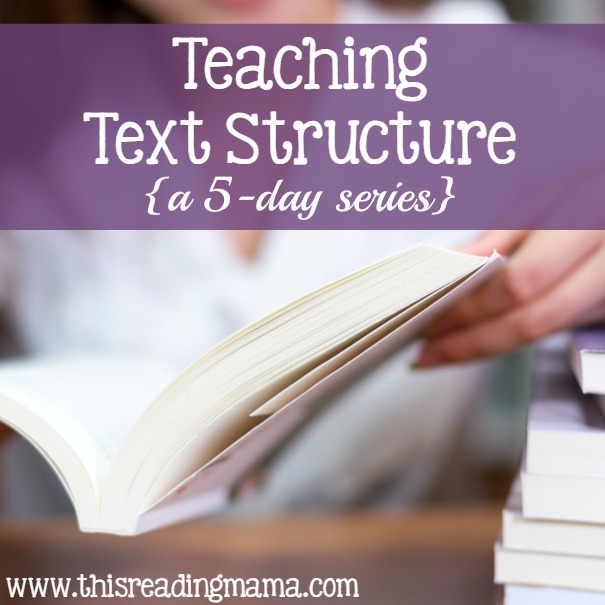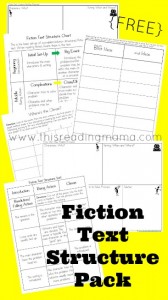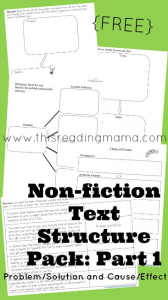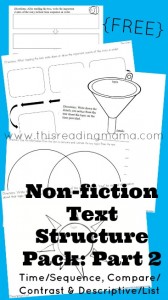
This week, I am posting a series called 5 Days of Teaching Text Structure. Text structure is one of those important topics to teach, but what exactly is it? Why is it important? At what ages should I start teaching it? What are some hands-on resources for teaching text structure? We will explore all these questions this week. For more 5 day series posts this week on teaching specific topics, visit iHomeschool Network’s January Hopscotch!
*Please note that this post contains affiliate links. To read more about this, visit my full disclosure policy.
What is Text Structure?
I will never forget the day that I was talking to a fellow teacher about the 4th grade student I was tutoring in reading. I explained how much he struggled with comprehending non-fiction text. I had focused heavily on comprehension strategies, but something still wasn’t clicking. She said, “Have you worked on text structure?” I just stared at her like she had asked me a question in a foreign language. She was kind enough to talk me through it a little and I knew right away, this was something I needed to research further. As I began focusing on text structure with him, I realized it was the missing piece to his puzzle of comprehension. And it is for many young readers!
What exactly is text structure? Simply put, text structure is the way in which the author has organized the information in the text. Text organization. “The physical layout,” as Emily Kissner puts it in her book, Summarizing, Paraphrasing, and Retelling. When you want to write a recipe, you format it like a recipe. Not a narrative story. When you write a note to a loved one, you typically format it like a letter. Not a descriptive passage.
Three BIG Reasons Text Structure is Important
- Comprehension. It gives readers a specific purpose for reading. Different kinds of texts are organized differently because they are to be read differently. We don’t read a letter the same way we read an instruction manual. Our purpose for reading directly affects our comprehension. The text structure is a signal to our brain to read the text in a certain way.
- Comprehension. It helps the reader understand what is important in the text. Authors usually organize their text so that readers can clearly see what is important or isn’t important. (With non-fiction, they also use text features to do this.)
- Comprehension (notice a theme?). Knowing the text structure helps readers to comprehend, looking for important topics and ideas so that they can retell and summarize the text. Once a student understands what the overall text structure is, he is better able to retell the story or summarize the text because he uses the structure of the text to guide his retelling. For example, a good retelling of a story includes the events in sequence; starting with the introduction, moving on towards the climax, and finishing with the resolution. When summarizing a non-fiction text that compares and contrasts whales and sharks, we want young readers to summarize the text by using a compare/contrast kind of structure.
“Talking about text organization helps students see the macrolevel, or overall structure, of the text, and gives them a framework to figure out how all the small pieces of information fit together.” -Emily Kissner (Summarizing, Paraphrasing, and Retelling, pg. 49-50)
When Do I Start Teaching Text Structure?
Text Structure. Just the sound of it seems like it should be a middle school term, right? But in reality, you actually start modeling text structure when you read to your baby, toddler, and/or preschooler! By listening to stories with a clear plot line (such as introduction, problem, character faces the problem, & problem solved at the end), we are helping our youngest readers become familiar with the structure of a story. When reading stories, we may talk about how the character got into trouble, but in the end, the problem was solved.
In Kindergarten, the books a child reads independently are typically more predictable in nature, such as the emergent readers you find in my Reading the Alphabet curriculum, so continuing to model is key. But as the child is able to read more difficult texts, the child can begin to take over some of the work with text structure. How exactly do you do this, especially in the younger grades? As we move forward this week, I hope to give you some tools and tips for teaching fiction and non-fiction text structure to kids K-5th grades.
“Text organization is something that students of all ages can and should learn.” –Summarizing, Paraphrasing, and Retelling by Emily Kissner, pg. 49
5 Days of Teaching Text Structure Links and Other Resources:
1. Introduction to Text Structure and Giveaway {you are here}
2. Fiction Text Structure Resources {FREE Fiction Text Structure Printable Pack*}
3. Nonfiction Text Structure Resources: {FREE Non-fiction Printable Pack for Problem/Solution and Cause/Effect*}
4. More Nonfiction Text Structure Resources {FREE Non-fiction Printable Pack for Time/Sequence, Compare/Contrast and Descriptive/List*}
5. Beyond Identification: Four Ways to Move Forward with Text Structure {Guest Post from Emily Kissner}
*Pictured Below are the FREE Printable Text Structure Organizers you will find for Fiction and Non-fiction on Days 2, 3, and 4. Click on the picture to view the post and download the pack!
–Teaching Kids How to Retell with Fiction (Fiction Text Structure)
–Teaching Young Readers how to Summarize
–Nonfiction Text Features and Text Structure

~Becky



This seems like an answer to what I was looking for. I would love to win either products.
I’ve never heard of text structure, but it seems to be important!
…and I prefer teaching with fiction based in fact.
I prefer to teach fiction better but now that we’ve started reading more nonfiction for homeschooling, it has really had an impact on my daughter. She asks so many questions and wants to know all the details behind how something works.
I enjoy both because they both have opportunities to focus on life…morals, history, humor, geography, etc.
text structure….really made me curious and helped me realize the importance of comprehension for an emergent reader
fiction at this stage…leaves me multiple choices to develop my teaching
So neat following!
It’s a close race between fiction and nonfiction. I gravitate more to fiction, as I enjoy reading fiction more, but nonfiction children’s books have come a long way and make teaching nonfiction a lot more enjoyable!
I don’t really have a preference. I enjoy teaching both.
I like them both, but non-fiction is my favorite!
It’s hard to choose which – if it is a subject the child is engaged in it doesn’t matter! 🙂
I’m so glad you share your expertise! I can’t wait to read the rest of the posts. I have two young readers, so this is very helpful.
Before having my own babies (both boys) I preferred teaching fiction. Now, I prefer non-fiction because my sons are so drawn to it!
This may be the answer to my son’s problems. He has a horrible time with his science text while on the other hand he does really great with his history. The history book is more like a storybook and he remembers so much. I thought he just hated science, but he’s always asking questions that are science related. When I get his book out to research the answer he tells me never mind and loses interest. Can’t wait for more on this.
I love to teach fiction! But my boys are definitely more drawn to nonfiction. I’m excited to read more!!
Fiction.
I am excited to learn more about text structure over the next 5 days. I tutor plenty of 3,4, & 5th graders and this will definitely help me improve their reading comprehension skills.
I like to teach fiction!
Another awesome series! Thank you so much!! I can’t tell you how much I have relied on your site this first year of homeschool. It’s been a Godsend!
What encouraging words! Thank you, Tracee.
I like teaching non-fiction better but enjoy fiction, too. Thanks for sharing your ideas with us!
I really love nonfiction!
I really enjoy teaching both fiction and non-fiction. Both are essential. Thank you for the information about text structure. Reading comprehension is so important and it helps students achieve so much more when they grasp this! I am looking forward to applying some of the concepts about text structure with my students. Thank you and God Bless!
Great post! I use many of Emily’s activities in my class. Love all her stuff!
I’m naturally more comfortable with nonfiction.
Nonfiction is easier for me.
I prefer nonfiction.
It really depends on my mood, and how much I like the book. There’s some great nonfiction books that I love to teach (besides fairy tales are nonfiction), but I also very much enjoy fiction books.
I would like to teach them in balance.
I like to teach fiction. Thanks so much, Caterina
If I am to teach something, I’d say “non-fiction” 🙂
I like Non fiction better.
I am just starting text structure next week and am looking forward to it. I prefer fiction.
I have been teaching text structure for years, but this puts it in a more organized way.
I’ve never heard of this but it’s interesting and and may help my little struggling reader.
As a reading teacher text structure is very important in understanding the story. I like both fiction and nonfiction books.
So happy to have won, thank you! I hope you received my email. Let me know if you didn’t.
Great post, Becky! This is something I don’t know too much about. I’ll pin this to the After School board if I don’t see you there already.
Wow! Thank you! I am leading a book club for my son’s class and I don’t really have any background on talking about any of this with kids. Your explanations are very helpful!